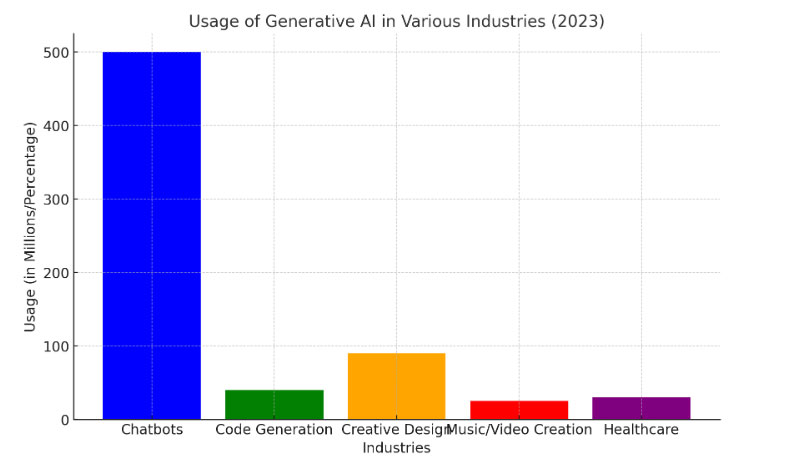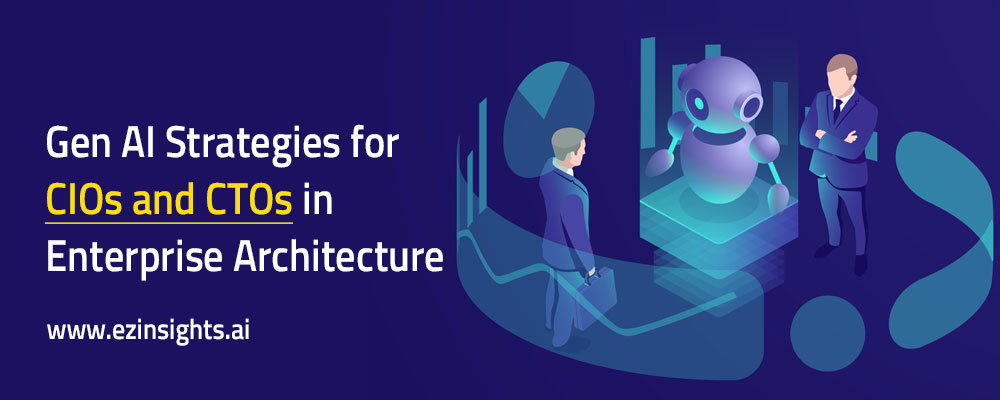In today’s fast changing technological landscape, Generative AI (Gen AI) has emerged as a game changer in business architecture. As Chief Information Officers (CIOs) and Chief Technology Officers (CTOs) navigate this complicated landscape, understanding and implementing effective Gen AI strategies is critical for driving innovation and attaining strategic objectives. This blog dives into top CIO and CTO strategies, with a focus on Gen AI frameworks, generative AI, and its applications in a variety of industries, including manufacturing.
Understanding Generative AI and Its Frameworks
Generative AI, often known as Gen AI, refers to artificial intelligence systems that may create new material, designs, or solutions by learning from previously collected data. Unlike traditional AI, which is primarily concerned with categorization and prediction, Gen AI generates innovative outputs, making it a game changer in corporate architecture.
Gen AI Frameworks serve as the structural underpinning for creating and implementing sophisticated systems. These frameworks provide a variety of approaches and methodologies for deploying Gen AI in different industrial environments. A well-defined Gen AI framework ensures that enterprises may maximize the benefits of generative AI while remaining in control of its ethical and operational implications.
Top Strategies for CIOs and CTOs
1. Adopt a Robust Gen AI Framework
Implementing a Gen AI framework is critical for organizing your AI projects. These frameworks usually include components for data administration, model training, deployment, and evaluation. A well-designed Gen AI framework assures alignment with your corporate goals, makes scalability easier, and gives a clear route for integrating AI into your existing architecture.
Key Elements of a Gen AI Framework:
Data Infrastructure: Ensures accurate data collection and management.
Model Training and Validation: Provides approaches for precise and dependable model development.
Deployment Strategies: Describes how to integrate AI models into production contexts.
Ethics and Compliance: Ensures responsible AI use and regulatory compliance.
2. Use Generative AI to Drive Innovation
Within your company, generative AI has the potential to be a potent innovation catalyst. You can explore new product concepts, streamline corporate procedures, and come up with original solutions to challenging issues by using generative models.
Use Cases for Innovation:
Product Development: Using pre-existing data to train models, create innovative product concepts and designs.
Process Optimization: Boost productivity by utilizing AI-generated fixes and process enhancements.
Customer/Consumer Journey: To increase consumer engagement, provide recommendations and personalized content.
3. Implement Generative AI for Manufacturing
Generative AI is transforming conventional methods in the manufacturing sector by facilitating more effective quality control, predictive maintenance, and design processes. Manufacturers can improve their operations and save a lot of money by integrating generative models.
Applications in Manufacturing:
Design Optimization: Quickly explore and improve design possibilities by utilizing generative models.
Predictive Maintenance: Use AI-generated insights to forecast equipment breakdowns and optimize maintenance plans.
Quality Control: Use AI-driven analysis to improve defect detection and quality assurance procedures.
4. Monitor and Evaluate Generative AI Performance
It’s imperative to do ongoing monitoring and assessment to make sure your generative AI systems function as intended and provide value. Evaluate AI model performance on a regular basis using pre-established metrics, and modify tactics as needed.
Evaluation Strategies:
Performance Metrics: Monitor the efficacy, efficiency, and correctness of outputs produced by AI.
Feedback Loops: AI systems can be improved and refined by taking user and stakeholder feedback into account.
Frequent Audits: Perform audits on a regular basis to make sure that rules and ethical standards are being followed.
Real Examples of Generative AI
Generative AI refers to AI systems capable of creating new content such as text, images, music, and code. Below are real-world examples of generative AI along with relevant facts and figures.
Chatbots and Virtual Assistants
Generative AI powers advanced chatbots like OpenAI’s GPT models, which generate human-like text. ChatGPT, for instance, is used in customer service and personal assistants. As of 2023, more than 500 million people have used ChatGPT for various tasks, significantly reducing customer service costs for businesses by up to 30%.
Text and Code Generation
Generative AI also aids in software development through tools like GitHub Copilot, which helps developers by generating code based on prompts. GitHub Copilot is responsible for generating 40% of newly written code in supported programming languages. It is estimated to reduce development time by as much as 55%, significantly enhancing productivity.
Creative Design and Art
In the creative industry, tools like DALL-E, Stable Diffusion, and Midjourney generate unique images and artwork based on text descriptions. In 2023, Adobe announced the integration of generative AI into Photoshop, impacting more than 90% of designers globally. These tools reduce the time required for content creation in industries such as marketing and design by 20-30%.
Music and Video Creation
Generative AI is also transforming the media industry. Tools like AIVA and Juke deck can compose music, while Runway ML generates videos from simple inputs. As of 2023, creators using Runway’s tools have generated over 25 million videos, helping to increase productivity in media production by around 20%.
Healthcare
In healthcare, IBM Watson employs generative AI for drug discovery by predicting the chemical structure of potential drugs. By 2023, Watson AI had contributed to the discovery of more than 30 promising drug compounds. Generative AI in this field has the potential to reduce the drug discovery timeline by up to 70%, accelerating the path from research to treatment.

Here is a bar chart representing the usage of Generative AI in various industries based on real-world examples and impact:
- Chatbots: Over 500 million users.
- Code Generation: 40% of new code generated by GitHub Copilot.
- Creative Design: 90% of designers impacted by generative AI in tools like Adobe.
- Music/Video Creation: 25 million videos generated using AI tools.
- Healthcare: AI-assisted in discovering 30 drug compounds.
The chart provides a visual representation of how different industries are leveraging generative AI for their operations.
The Importance of a Generative AI Report
Insight into Emerging Trends
A Generative AI report offers valuable insights into the latest trends and advancements in AI-driven content creation. It highlights how industries are adopting these technologies and the impact on productivity, creativity, and efficiency.
Strategic Business Decisions
Such a report can serve as a roadmap for businesses by providing data-backed analysis on how generative AI can be integrated into operations. This helps in making informed decisions to stay competitive and innovative.
Understanding Market Adoption
A comprehensive report helps readers understand the extent of market adoption, detailing how different sectors like healthcare, finance, and media are leveraging generative AI to enhance their workflows.
Risk and Ethical Considerations
Generative AI reports often highlight potential risks such as data privacy, ethical dilemmas, and AI bias. This allows businesses and policymakers to mitigate risks by adopting responsible AI practices.
Future-Proofing Organizations
By focusing on the future potential of AI-driven technologies, the report provides insights into how companies can prepare for future disruptions, enabling them to future-proof their operations and remain leaders in their fields.
Components of a Generative AI Report:
Executive Summary: High-level synopsis of AI initiatives and results.
Performance analysis: In-depth examination of the influence and performance of AI models.
Strategic Alignment: Assessing the degree to which AI projects complement organizational objectives.
Recommendations/Suggestions: Plans for upcoming enhancements and tactical modifications.
Conclusion
To effectively integrate and utilize generative models in your organizational architecture, CIOs and CTOs must take a strategic approach to embracing Gen AI, which goes beyond simply implementing new technologies. You may put your company at the forefront of technology innovation by building a strong Gen AI foundation, utilizing cutting-edge apps, and closely observing performance. Effective generative AI application improves operational effectiveness and strategic decision-making in addition to stimulating innovation.
FAQs
What are the key benefits of adopting Generative AI in enterprise architecture?
Generative AI enhances enterprise architecture by automating design processes, optimizing workflows, and providing predictive analytics. This leads to increased efficiency, reduced costs, and improved decision-making capabilities for CIOs and CTOs.
How can CIOs and CTOs effectively integrate Generative AI into their existing systems?
Effective integration involves assessing current infrastructure, ensuring compatibility, and leveraging scalable AI platforms. CIOs and CTOs should prioritize pilot projects and continuous monitoring to address challenges and refine strategies.
What challenges might arise when implementing Generative AI in enterprise architecture?
Common challenges include data quality issues, integration complexities, and resistance to change. Addressing these involves investing in training, choosing the right tools, and maintaining clear communication with stakeholders.
How can Generative AI drive innovation in enterprise architecture?
Generative AI fosters innovation by enabling advanced simulations, personalized solutions, and rapid prototyping. It allows CIOs and CTOs to explore new possibilities, streamline processes, and stay competitive in a dynamic market.

Anupama Desai
President & CEO
Anupama has more than 23 years of experience as business leader and as an advocate for improving the life of the business users. Anupama has been very active in bringing business perspective in the technology enabled world. Her passion is to leverage information and data insights for better business performance by empowering people within the organization. Currently, Anupama leads Winnovation to build world class Business Intelligence application platform and her aim is to provide data insights to each and every person within an organization at lowest possible cost.

